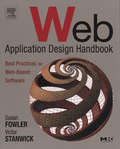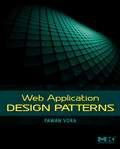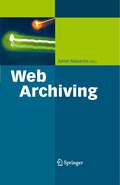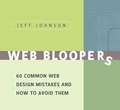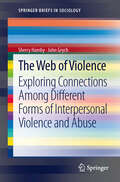- Table View
- List View
Web and Communication Technologies and Internet-Related Social Issues - HSI 2005: 3rd International Conference on Human-Society@Internet, Tokyo, Japan, July 27-29, 2005, Proceedings (Lecture Notes in Computer Science #3597)
by Shinji Shimojo Shingo Ichii Tok Wang Ling Kwan-Ho SongThe Internet has now become an integral part of everyday life for hundreds of millions of people around the world. The uses of the Internet have augmented commerce, communication, education, governance, entertainment, health care, etc. E-mail has become an indispensable part of life; the Web has become an indispensable source of information on just about everything; people now use governmentWebsitestoreceiveinstructionsandinformation,and?lepaperwork with the government; many major online businesses have been created, such as Amazon, eBay, Google, Travelocity, eTrade, etc. However, the uses of the Internet have also had serious negative e?ects, - cluding spam, the spreading of viruses and worms, spyware, phishing, hacking, online fraud, invasions of privacy, etc. Viruses and worms often bring down tens of millions of computers around the world; many people get duped into furni- ing their personal identi?cations, and bank and insurance account information, etc. ; hackers break into government and corporation computers to steal cri- cal data; unsubstantiated rumors about individuals or organizations spread like wild?re on the Internet, etc. Further, the uses of the Internet are creating new paradigms in areas such as copyright, governance, etc. The widespread use of peer-to-peer ?le sharing systems, started by Napster,is forcing a reassessment of the value of holding copyright on digital media. Internet postings by vocal citizens to the Web sites of the news media, governmento?ces, and elected g- ernment o?cials are impacting government policies and swaying the opinions of other citizens. The aim of the International Conference on Human.
The Web and Faith: Theological Analysis of Cyberspace Technologies
by Ayse KokComputing technology is an indispensable feature of modern life. Our rapid-paced world seems more and more remote from the world narrated in sacred scriptures. However, despite its pervasiveness, there remains a dearth of theological reflection about computer technology and what it means to live as a faithful individual in a digitally - saturated society.The Web and Faith provides a brief theology of technology, rooted in the Islamic tradition and oriented around the grand themes of creation, redemption and new creation. The book combines a concise, accessible style with penetrating cultural and theological analysis. Building on the work of Marshall McLuhan and Neil Postman, and drawing from a wide range of enlightened Islamic thinkers, the book situates computer technology within the big picture of the story of creation. Technology is not neutral, but neither is there an exclusively ''faith-based'' form of technological production and use. Instead, this book guides us to see the digital world as part of a larger creation, which is redeemable according to the law of faith. Responsibly used, technology can become an integral part of religious wisdom world-wide.
The Web and Faith: Theological Analysis of Cyberspace Technologies
by Ayse KokComputing technology is an indispensable feature of modern life. Our rapid-paced world seems more and more remote from the world narrated in sacred scriptures. However, despite its pervasiveness, there remains a dearth of theological reflection about computer technology and what it means to live as a faithful individual in a digitally - saturated society.The Web and Faith provides a brief theology of technology, rooted in the Islamic tradition and oriented around the grand themes of creation, redemption and new creation. The book combines a concise, accessible style with penetrating cultural and theological analysis. Building on the work of Marshall McLuhan and Neil Postman, and drawing from a wide range of enlightened Islamic thinkers, the book situates computer technology within the big picture of the story of creation. Technology is not neutral, but neither is there an exclusively ''faith-based'' form of technological production and use. Instead, this book guides us to see the digital world as part of a larger creation, which is redeemable according to the law of faith. Responsibly used, technology can become an integral part of religious wisdom world-wide.
Web Application Design Handbook: Best Practices for Web-Based Software (Interactive Technologies)
by Susan Fowler Victor StanwickThe standards for usability and interaction design for Web sites and software are well known. While not everyone uses those standards, or uses them correctly, there is a large body of knowledge, best practice, and proven results in those fields, and a good education system for teaching professionals "how to." For the newer field of Web application design, however, designers are forced to reuse the old rules on a new platform. This book provides a roadmap that will allow readers to put complete working applications on the Web, display the results of a process that is running elsewhere, and update a database on a remote server using an Internet rather than a network connection. Web Application Design Handbook describes the essential widgets and development tools that will the lead to the right design solutions for your Web application. Written by designers who have made significant contributions to Web-based application design, it delivers a thorough treatment of the subject for many different kinds of applications, and provides quick reference for designers looking for some fast design solutions and opportunities to enhance the Web application experience. This book adds flavor to the standard Web design genre by juxtaposing Web design with programming for the Web and covers design solutions and concepts, such as intelligent generalization, to help software teams successfully switch from one interface to another.* The first interaction design book that focuses exclusively on Web applications.* Full-color figures throughout the book.* Serves as a "cheat sheet" or "fake book" for designers: a handy reference for standards, rules of thumb, and tricks of the trade.* Applicable to new Web-based applications and for porting existing desktop applications to Web browsers.
Web Application Design Patterns (Interactive Technologies)
by Pawan VoraEver notice that—in spite of their pervasiveness—designing web applications is still challenging? While their benefits motivate their creation, there are no well-established guidelines for design. This often results in inconsistent behaviors and appearances, even among web applications created by the same company. Design patterns for web applications, similar in concept to those for web sites and software design, offer an effective solution. In Web Application Design Patterns, Pawan Vora documents design patterns for web applications by not only identifying design solutions for user interaction problems, but also by examining the rationale for their effectiveness, and by presenting how they should be applied.Design interfaces faster, with a better rationale for the solutions you choose.Learn from over more than 100 patterns, with extensive annotation on use and extension.Take a short-cut into understanding the industry with more than 500 full-color screenshots.
Web Application Security: Iberic Web Application Security Conference, IBWAS 2009, Madrid, Spain, December 10-11, 2009. Revised Selected Papers (Communications in Computer and Information Science #72)
by Carlos Serrao Vicente Aguilera Fabio CerulloIBWAS 2009, the Iberic Conference on Web Applications Security, was the first international conference organized by both the OWASP Portuguese and Spanish ch- ters in order to join the international Web application security academic and industry communities to present and discuss the major aspects of Web applications security. There is currently a change in the information systems development paradigm. The emergence of Web 2. 0 technologies led to the extensive deployment and use of W- based applications and Web services as a way to develop new and flexible information systems. Such systems are easy to develop, deploy and maintain and they demonstrate impressive features for users, resulting in their current wide use. The “social” features of these technologies create the necessary “massification” effects that make millions of users share their own personal information and content over large web-based int- active platforms. Corporations, businesses and governments all over the world are also developing and deploying more and more applications to interact with their bu- nesses, customers, suppliers and citizens to enable stronger and tighter relations with all of them. Moreover, legacy non-Web systems are being ported to this new intrin- cally connected environment. IBWAS 2009 brought together application security experts, researchers, educators and practitioners from industry, academia and international communities such as OWASP, in order to discuss open problems and new solutions in application security. In the context of this track, academic researchers were able to combine interesting results with the experience of practitioners and software engineers.
Web Archiving
by Julien MasanèsThis book assembles contributions from computer scientists and librarians that altogether encompass the complete range of tools, tasks and processes needed to successfully preserve the cultural heritage of the Web. It combines the librarian’s application knowledge with the computer scientist’s implementation knowledge, and serves as a standard introduction for everyone involved in keeping alive the immense amount of online information.
Web Bloopers: 60 Common Web Design Mistakes, and How to Avoid Them (Interactive Technologies)
by Jeff JohnsonThe dot.com crash of 2000 was a wake-up call, and told us that the Web has far to go before achieving the acceptance predicted for it in '95. A large part of what is missing is quality; a primary component of the missing quality is usability. The Web is not nearly as easy to use as it needs to be for the average person to rely on it for everyday information, commerce, and entertainment.In response to strong feedback from readers of GUI BLOOPERS calling for a book devoted exclusively to Web design bloopers, Jeff Johnson calls attention to the most frequently occurring and annoying design bloopers from real web sites he has worked on or researched. Not just a critique of these bloopers and their sites, this book shows how to correct or avoid the blooper and gives a detailed analysis of each design problem. Hear Jeff Johnson's interview podcast on software and website usability at the University of Canterbury (25 min.)Discusses in detail 60 of the most common and critical web design mistakes, along with the solutions, challenges, and tradeoffs associated with them. Covers important subject areas such as: content, task-support, navigation, forms, searches, writing, link appearance, and graphic design and layout. Organized and formatted based on the results of its own usability test performed by web designers themselves.Features its own web site (www.web-bloopers.com)with new and emerging web design no-no's (because new bloopers are born every day) along with a much requested printable blooper checklist for web designers and developers to use.
Web Communication Technologies and Internet-Related Social Issues - HSI 2003: Second International Conference on Human Society@Internet, Seoul, Korea, June 18-20, 2003, Proceedings (Lecture Notes in Computer Science #2713)
by Chin-Wan Chung Chong-Kwon Kim Won Kim Tok-Wang Ling Kwan-Ho SongThe refereed proceedings of the Second International Conference on Human.Society@Interet, HSI 2003,held in Seoul, Korea, in June 2003. The 57 revised full papers and 31 revised short papers presented were carefully reviewed and selected from 219 submissions. The papers are organized in topical sections on Web performance, authentication, social issues, security and document access, routing, XML, Internet applications, e-business, scheduling and resource allocation, wireless networks, Web components, multimedia communications, e-payment and auctions, cyber education, mobility and handoff, Internet protocols, mobile agents, and communications.
Web Engineering: International Conference, ICWE 2003, Oviedo, Spain, July 14-18, 2003. Proceedings (Lecture Notes in Computer Science #2722)
by Juan Manuel Cueva Lovelle María Del Puerto Paule De Ruiz Bernardo Martín González Rodríguez Luis Joyanes Aguilar Jose Emilio Labra GayoThe refereed proceedings of the International Conference on Web Engineering, ICWE 2003, held in Oviedo, Spain in July 2003. The 25 revised full papers and 73 short papers presented together with 2 invited papers were carefully reviewed and selected from 190 submissions. The papers are organized in topical sections on agents on the Web, e-commerce, e-learning, human-computer interaction, languages and tools, mobility and the Web, multimedia techniques and telecommunications, security, Web quality and testing, semantic Web, and Web applications development.
Web Engineering: 24th International Conference, ICWE 2024, Tampere, Finland, June 17–20, 2024, Proceedings (Lecture Notes in Computer Science #14629)
by Maristella Matera Kari Systä Kostas Stefanidis Elisa Quintarelli Sebastian Heil Haridimos KondylakisThis book constitutes the proceedings of the 24th International Conference, ICWE 2024, held in Tampere, Finland, during June 17-20, 2024. The 16 full papers and 8 short papers included in this volume were carefully reviewed and selected from 66 submissions. This volume includes all the accepted papers across various conference tracks. The ICWE 2024 theme, “Ethical and Human-Centric Web Engineering: Balancing Innovation and Responsibility,” invited discussions on creating Web technologies that are not only innovative but also ethical, transparent, privacy-focused, trustworthy, and inclusive, putting human needs and well-being at the core.
Web Information Systems Engineering – WISE 2007: 8th International Conference on Web Information Systems Engineering, Nancy, France, December 3-7, 2007, Proceedings (Lecture Notes in Computer Science #4831)
by Boualem Benatallah Fabio Casati Dimitrios Georgakopoulos Claudio Bartolini Wasim Sadiq Claude GodartThis book constitutes the proceedings of the 8th International Conference on Web Information Systems Engineering, WISE 2007, held in Nancy, France, in December 2007. The papers are organized in topical sections on querying, trust, caching and distribution, interfaces, events and information filtering, data extraction, transformation, and matching, ontologies, rewriting, routing, and personalisation, agents and mining, QOS and management, modeling, and topics.
Web Information Systems Engineering - WISE 2005: 6th International Conference on Web Information Systems Engineering, New York, NY, USA, November 20-22, 2005, Proceedings (Lecture Notes in Computer Science #3806)
by Anne H. H. Ngu Masaru Kitsuregawa Erich Neuhold Jen-Yao Chung Quan Z. ShengThis book constitutes the proceedings of the 6th International Conference on Web Information Systems Engineering, WISE 2005, held in New York, NY, USA, in November 2005. The 30 revised full papers and 20 revised short papers presented together with 18 poster papers were carefully reviewed and selected from 259 submissions. The papers are organized in topical sections on Web mining, Web information retrieval, metadata management, ontology and semantic Web, XML, Web service method, Web service structure, collaborative methodology, P2P, ubiquitous and mobile, document retrieval applications, Web services and e-commerce, recommendation and Web information extraction, P2P, grid and distributed management, and advanced issues. The presentation is rounded off by 14 industrial papers and the abstracts of 4 tutorial sessions.
Web Information Systems Engineering - WISE 2008: 9th International Conference, Auckland, New Zealand, September 1-3, 2008, Proceedings (Lecture Notes in Computer Science #5175)
by James Bailey David Maier Klaus-Dieter Schewe Bernhard Thalheim X. Sean WangThis book constitutes the proceedings of the 9th International Conference on Web Information Systems Engineering, WISE 2008, held in Auckland, New Zealand, in September 2008. The 17 revised full papers and 14 revised short papers presented together with two keynote talks were carefully reviewed and selected from around 110 submissions. The papers are organized in topical sections on grid computing and peer-to-peer systems; Web mining; rich Web user interfaces; semantic Web; Web information retrieval; Web data integration; queries and peer-to-peer systems; and Web services.
Web Information Systems - WISE 2006: 7th International Conference in Web Information Systems Engineering, Wuhan, China, October 23-26, 2006, Proceedings (Lecture Notes in Computer Science #4255)
by Karl Aberer Zhiyong Peng Elke A. Rundensteiner Yanchun Zhang Xuhui LiThis book constitutes the proceedings of the 7th International Conference on Web Information Systems Engineering, WISE 2006, held in Wuhan, China in October 2006. The 37 revised full papers and 17 revised short papers presented together with three invited lectures were carefully reviewed and selected from 183 submissions.
Web Journalism: A New Form of Citizenship?
by Sean TunneyThis book provides a much-needed analytical account of the implications of interactive participation in the construction of media content. Although web journalism is a fast-changing technology this book will have sustained appeal to an international readership by seeking to critically assess Internet news production. With the rise of blogging and citizen journalism, it is a commonplace to observe that interactive participatory media are transforming the relationship between the traditional professional media and their audience. A current, popular, assumption is that the traditional flow of information from media to citizen is being reformed into a democratic dialogue between members of a community. The editors and contributors analyse and debate this assumption through international case studies that include the United Kingdom and United States. While the text has been written and designed for undergraduate and postgraduate use, the book will be of use and of interest to all those engaged in the debate over Web reporting and citizen journalism.
Web Mining: First European Web Mining Forum, EWMF 2003, Cavtat-Dubrovnik, Croatia, September 22, 2003, Revised Selected and Invited Papers (Lecture Notes in Computer Science #3209)
by Maarten Van Someren Myra Spiliopoulou Gerd Stumme Bettina Berendt Andreas Hotho Dunja MladenicIn the last years, research on Web mining has reached maturity and has broadened in scope. Two different but interrelated research threads have emerged, based on the dual nature of the Web: – The Web is a practically in?nite collection of documents: The acquisition and - ploitation of information from these documents asks for intelligent techniques for information categorization, extraction and search, as well as for adaptivity to the interests and background of the organization or person that looks for information. – The Web is a venue for doing business electronically: It is a venue for interaction, information acquisition and service exploitation used by public authorities, n- governmental organizations, communities of interest and private persons. When observed as a venue for the achievement of business goals, a Web presence should be aligned to the objectives of its owner and the requirements of its users. This raises the demand for understandingWeb usage, combining it with other sources of knowledge inside an organization, and deriving lines of action. ThebirthoftheSemanticWebatthebeginningofthedecadeledtoacoercionofthetwo threadsintwoaspects:(i)theextractionofsemanticsfromtheWebtobuildtheSemantic Web;and(ii)theexploitationofthesesemanticstobettersupportinformationacquisition and to enhance the interaction for business and non-business purposes. Semantic Web mining encompasses both aspects from the viewpoint of knowledge discovery.
The Web of Violence: Exploring Connections Among Different Forms of Interpersonal Violence and Abuse (SpringerBriefs in Sociology)
by Sherry Hamby John GrychThere is an increasing appreciation of the interconnections among all forms of violence. These interconnections have critical implications for conducting research that can produce valid conclusions about the causes and consequences of abuse, maltreatment, and trauma. The accumulated data on co-occurrence also provide strong evidence that prevention and intervention should be organized around the full context of individuals’ experiences, not narrowly defined subtypes of violence. Managing the flood of new research and practice innovations is a challenge, however. New means of communication and integration are needed to meet this challenge, and the Web of Violence is intended to contribute to this process by serving as a concise overview of the conceptual and empirical work that form a basis for understanding the interconnections across forms of violence throughout the lifespan. It also offers ideas and directions for prevention, intervention, and public policy.A number of initiatives are emerging to integrate the findings on co-occurrence into research and action. The American Psychological Association established a new journal, Psychology of Violence, which is a forum for research on all types of violence. Sherry Hamby is the founding editor and John Grych is associate editor and co-editor of a special issue on the co-occurrence of violence in 2012. Dr. Hamby also is a co-investigator of the National Survey of Children’s Exposure to Violence (NatSCEV), which has drawn attention to polyvictimization. Polyvictimization is a focus of the U.S. Department of Justice’s Defending Childhood Initiative and has recently been featured in calls for grant proposals by the Office of Victims of Crime and National Institutes for Justice.
Web of Violence: A Study of Family Violence (Routledge Library Editions: Family)
by Jean RenvoizeSome of the most frightening and harmful violence in modern society takes place inside the family. Wives, children, grandparents, all of them can be subject to attacks that range from mild ‘roughing up’ to assaults that leave the victim physically or psychologically crippled. What causes this violence? What sort of people are the attackers and the victims? What can we do to diminish it and to help those who suffer? Originally published in 1978, Jean Renvoize author of the highly praised Children in Danger traces the web of violence along many different strands. She covers baby battering and child abuse, violent husbands and wives, ‘granny bashing’ and incest. She looks at the psychological roots and the social patterns; she also surveys the agencies that act to prevent family violence, from social workers and those who run refuges to police and doctors. She suggests a number of positive steps that could and should be taken to improve society’s response. As in Children in Danger, she draws on many first-hand sources of information, not only professionals working in the field but also the detailed and intimate self-revelations of both victims and batterers. The first chapter – an almost unbelievable account by a girl caught up in four generations of violence, whose sufferings make her recoil from it and yet at the same time draw her inexorably deeper in, both as victim and aggressor – is the first of many case histories on which Jean Renvoize draws. Her book is an extraordinary document about humanity, as well as an essential guide for anyone who has to deal with the problems it discusses with such insight and objectivity.
Web of Violence: A Study of Family Violence (Routledge Library Editions: Family)
by Jean RenvoizeSome of the most frightening and harmful violence in modern society takes place inside the family. Wives, children, grandparents, all of them can be subject to attacks that range from mild ‘roughing up’ to assaults that leave the victim physically or psychologically crippled. What causes this violence? What sort of people are the attackers and the victims? What can we do to diminish it and to help those who suffer? Originally published in 1978, Jean Renvoize author of the highly praised Children in Danger traces the web of violence along many different strands. She covers baby battering and child abuse, violent husbands and wives, ‘granny bashing’ and incest. She looks at the psychological roots and the social patterns; she also surveys the agencies that act to prevent family violence, from social workers and those who run refuges to police and doctors. She suggests a number of positive steps that could and should be taken to improve society’s response. As in Children in Danger, she draws on many first-hand sources of information, not only professionals working in the field but also the detailed and intimate self-revelations of both victims and batterers. The first chapter – an almost unbelievable account by a girl caught up in four generations of violence, whose sufferings make her recoil from it and yet at the same time draw her inexorably deeper in, both as victim and aggressor – is the first of many case histories on which Jean Renvoize draws. Her book is an extraordinary document about humanity, as well as an essential guide for anyone who has to deal with the problems it discusses with such insight and objectivity.
Web Search: Multidisciplinary Perspectives (Information Science and Knowledge Management #14)
by Amanda Spink Michael ZimmerWeb search engines are not just indispensable tools for finding and accessing information online, but have become a defining component of the human condition and can be conceptualized as a complex behavior embedded within an individual's everyday social, cultural, political, and information-seeking activities. This book investigates Web search from the non-technical perspective, bringing together chapters that represent a range of multidisciplinary theories, models, and ideas.
Web Services – ICWS 2019: 26th International Conference, Held as Part of the Services Conference Federation, SCF 2019, San Diego, CA, USA, June 25–30, 2019, Proceedings (Lecture Notes in Computer Science #11512)
by John Miller Eleni Stroulia Kisung Lee Liang-Jie ZhangThis volume constitutes the proceedings of the 26th International Conference on Web Services, ICWS 2019, held as part of SCF 2019 in San Diego, CA, USA in June 2019. The 11 full papers together with 1 short paper published in this volume were carefully reviewed and selected from 31 submissions. ICWS has been a prime international forum for both researchers and industry practitioners to exchange the latest fundamental advances in the state of the art and practice of Web-based services, to identify emerging research topics, and to define the future of Web-based services. Topics include Internet services modeling, discovery, composition, testing, adaptation, delivery, as well as standards.
Web Services, E-Business, and the Semantic Web: CAiSE 2002 International Workshop, WES 2002, Toronto, Canada, May 27-28, 2002, Revised Papers (Lecture Notes in Computer Science #2512)
by Christoph Bussler Richard Hull Sheila A. McIlraith Maria E. Orlowska Barbara Pernici Jian YangWeb Services - ICWS-Europe 2003: International Conference ICWS-Europe 2003, Erfurt, Germany, September 23-24, 2003, Proceedings (Lecture Notes in Computer Science #2853)
by Mario Jeckle Liang-Jie ZhangAfter some time of early experience Web Services are moving themselves from a new highly fragmented technology to a piece of nowadays infrastructures which promise to address various current challenges. These include especially classical issues of integration and data in a heterogeneous environment. The Web Service technology provides an open and technology-agnostic interface, and furthermore propels new usage paradigms in distributed computing infrastructures like Grid Services. Successful adoption of Web Service technology relies on the de?nition of interoperable architectural building blocks which can be integrated in existing softwarearchitectures,likeJ2EEorCORBAheritage. Interoperabilitywillsurely proveitselfasthecriticalsuccessfactoroftheWebServiceproliferation. Inorder to accomplish these interoperability various standardization bodies such as the W3C, UN or OASIS founded activities to create speci?cations and products implementing these building blocks. As the sister event of the First International Conference on Web Services (ICWS 2003), which was held in Las Vegas, June 23 - 26, USA, has proven to be an excellent catalyst for research and collaboration, the 2003 International C- ference on Web Services - Europe (ICWS-Europe 2003) is expected to continue this trend. The topics of papers collected in this proceedings volume ranges from issues like modeling, development, deployment, publishing, as well as discovery, composition and collaboration, plus monitoring and analytical control. Addit- nal contributions summarize some research and development challenges of bu- ding Web Service solutions. Especially, some contributions present an emerging research direction, namely, Web Services collaboration. Moreover, some major research activities associated with facilitating extended business collaboration using Web services and semantic annotation are also covered.
Web Technologies Research and Development - APWeb 2005: 7th Asia-Pacific Web Conference, Shanghai, China, March 29 - April 1, 2005, Proceedings (Lecture Notes in Computer Science #3399)
by Yanchun Zhang Katsumi Tanaka Jeffrey Xu Yu Shan Wang Minglu LiThis volume contains papers selected for presentation at the 7th Asia Pacific Conference on Web Technology (APWeb 2005), which was held in Shanghai, China during March 29–April 1, 2005. APWeb is an international conference series on WWW technologies and is the primary forum for researchers and practitioners from both academia and industry to exchange knowledge on WWW-related technologies and new advanced applications. APWeb 2005 received 420 submissions from 21 countries and regions worldwide, including China, Korea, Australia, Japan, Taiwan, France, UK, Canada, USA, India, Hong Kong, Brazil, Germany, Thailand, Singapore, Turkey, Spain, Greece, Belgium, New Zealand, and UAE. After a thorough review process for each submission by the Program Committee members and expert reviewers recommended by PC members, APWeb 2005 accepted 71 regular research papers (acceptance ratio 16.9%) and 22 short papers (acceptance ratio 5.2%). This volume also includes 6 keynote papers and 11 invited demo papers. The keynote lectures were given by six leading experts: Prof. Ah Chung Tsoi (Australia Research Council), Prof. Zhiyong Liu (National Nature Science Foundation of China), Prof. John Mylopoulos (University of Toronto), Prof. Ramamohanarao (Rao) Kotagiri (University of Melbourne), Prof. Calton Pu (Georgia Tech), and Prof. Zhiwei Xu (Chinese Academy of Sciences).


